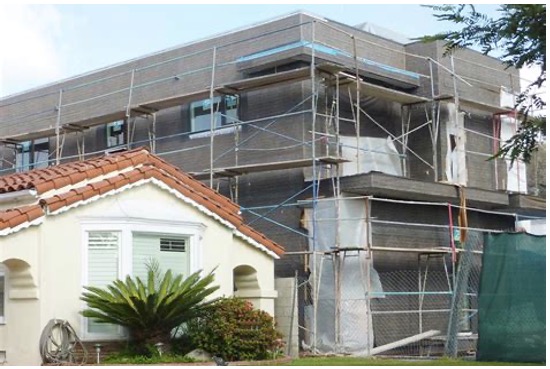CommentsPLANNING WATCH - In previous Planning Watch columns I explained why the end of eviction protections; the growth of economic inequality, housing prices, and interest rates; and the demise of HUD and CRA public housing has led to overcrowding and homelessness.
But there is another cause of overcrowding and homelessness. It is mansionization, the demolition of older, smaller, less expensive houses by real estate speculators who quickly replace them with spec McMansions: boxy, shoddily built houses that max out the permitted building envelope.
Furthermore, in Los Angeles three pseudo legislative protections against mansionization do not work: Interim Control Ordinances, Residential Floor Area Districts (RFA), and Baseline Mansionization Ordinance/R-1 variation zones. They are filled with loopholes, and LA’s Department of Building and Safety poorly enforces them. The one exception is LA’s 35 Historical Preservation Overlay Zones (HPOZ’s), many of which were adopted before the current McMansion period (2000 – date).
While rising income inequality leads to overcrowding and homelessness among most Angelinos, the small percentage of Angelinos with high incomes continue to rent luxury apartments and buy McMansions. In effect, these housing trends are opposite sides of the same coin. They share the same cause: rising income inequality. The poor get poorer and end up overcrowded or homeless, while the rich get richer and end up buying McMansions.
Why is this happening? Real estate investors and contractors avoid money-losing low-priced housing. Instead, they maximize their profits by building, renting, and selling luxury apartments and McMansions to a small, but highly affluent market segment. This also accounts for the Reaganesque housing laws that the California State Legislature recently enacted, especially Senate Bill 9, a statewide residential up-zoning ordinance. It also explains the 26 new land use ordinances appended to the soon-to-be approved Downtown Community Plan Update. Once in place, these ordinances will become templates for the 34 other Community Plan Updates.
There are few reasons for investors and contractors to buy and demolish single-family houses and then replace them with four-plex apartment buildings. Instead real estate speculators opt for more profitable, hassle-free McMansions. Unlike the new SB 9 apartment option, McMansions are sold to owner-occupants who either live in them for two years because of tax laws, or who skirt LA’s short-term rental ordinance and lease them to visitors, often illegally.

Photoshopped McMansion in Los Angeles.
But McMansions have additional, adverse impacts on the housing market:
- McMansions replace lower-priced housing and their residents with expensive housing.
- While McMansions, on average, are three times larger and costlier than the houses they replace, they shelter the same number of people. Population density does not change, only building intensity.
- McMansions use more electricity and water than the previous homes. This is one reason why heavily mansionized neighborhoods in Los Angeles, like Beverly Grove, have such frequent LADWP electrical blackouts.
- McMansions become larger as residentially-zoned parcels become larger. This is why lots zoned for duplexes produce super-sized McMansions, not new or replacement duplexes. Regardless of up-zoning, developers will continue to build McMansions because they are extremely profitable, without the hassles of becoming a landlord.
- Since most McMansion are designed with large, front garages, they encourage energy-intensive, Greenhouse Gas spewing, automobile use.
- McMansions are also energy hogs. They feature whole house vacuum systems, 24/7 heating and air conditioning, pools and spas, prominent garages, and restaurant-style appliances.
- The high cost of buying or renting a McMansions pulls up housing costs in surrounding buildings.
What can be done?
Step 1 is compiling mansionization data. Since nearly all demolished single-family homes are replaced with McMansions, this is the obvious place to begin. While the City offers partial data, including house demolitions between 2016 and 2022, this is just a start. To develop sound policy, we need long-term citywide data on house demolitions going back to the year 2000, the beginning of the McMansion era.
Step 2 is better land use regulations and enforcement based on adopted General Plan policies. For example, LA’s 35 Community Plans contain this or similar language.
“Protect existing stable single family and low density residential neighborhoods from encroachment by higher density residential uses and other uses that are incompatible as to scale, character, or would otherwise diminish quality of life.”
Step 3 is plugging the loop holes in existing anti-mansionization ordinances, then demanding that LADBS properly enforce these amended ordinances.
Step 4 is adopting localized versions of other cities’ effective anti-mansionization ordinances:
Pasadena’s anti-mansionization ordinance limits the size of new houses to no more than 35% above the median size of nearby homes.
Beverly Hills has pursued a different approach: mandatory design review of all proposed single family homes to maintain the scale and character of existing residential neighborhoods.
These four steps won’t happen on their own. They will require enormous pressure from below on the new Mayor and revamped City Council.
(Dick Platkin ([email protected]) is a former Los Angeles city planner who reports on local planning issues for CityWatchLA. He serves on the board of United Neighborhoods for Los Angeles (UN4LA). Previous Planning Watch columns are available at the CityWatchLA archives.)
















